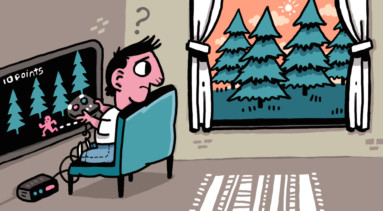
It is now 12 years since the American author Richard Louv pointed out that something new and potentially very damaging was happening to children: they were retreating from the world of outside. Young people were no longer playing in the fields, woods and parks where their parents played, and they were losing contact with nature: for their leisure time, they were retreating back inside the house.
In Last Child in the Woods, Louv documented the causes and consequences. Of the reasons, two stood out: parents’ mushrooming fear of “stranger danger”, the belief that outside has become a very risky place for the unaccompanied young; and the powerful attraction of electronic screens, of computer games and the internet for children themselves.
The consequences of their increasing alienation from the natural world, Louv said, included diminished use of the senses, attention difficulties and higher rates of physical and emotional illnesses. He gave the syndrome a name: nature deficit disorder.
Louv’s work focused on the consequences for children. But there are also consequences for the hedgehogs, butterflies, birds and fish that modern children are so much less familiar with than previous generations were. Children not aware of or interested in the natural world will be less likely to grow into its defenders, at a time when it is under mortal threat as a consequence of climate change and other factors.
In the years since Louv’s book, much attention has been given to this issue, and in the past decade there have been reports from groups including Natural England, the National Trust and the RSPB. All draw pretty much the same conclusions: a majority of children no longer climb trees or play by streams and ponds, have become largely unfamiliar with even common wildlife, and are leading enclosed lives that are potentially harmful for their emotional and physical development.
It’s been an awful lot of talk, but what has been the result? Some wildlife charities and schools are indeed making efforts to reconnect young people with nature, but what has been missing is any sort of strategic reaction to what is so widely perceived as a national problem. This is why a recently launched petition to the government is so interesting: it calls for the development of a GCSE in natural history.
Its proposer is the radio and TV producer Mary Colwell, an increasingly influential figure in the field of nature conservation. Last year she made a solo 500-mile (805km) walk from western Ireland to East Anglia to publicise the plight of the curlew — the wading bird with the decurved beak and the lovely bubbling song in springtime, which is declining in numbers in much of Britain, and in Ireland is rapidly heading for extinction. As a result of her efforts, the Irish government has set up a task force to try to bring the bird back from the brink.
Obvious difficulties
Colwell’s idea is “to make nature part of British society again”. The subject should not be folded into biology, which is about life processes, she thinks; rather, the syllabus should reflect the long-standing British amateur-naturalist tradition of observing and recording organisms and events in the natural world through the seasons. The potential difficulties are obvious. Who would teach it? Would a new cadre of natural history teachers have to be developed? Which schools would want to offer it, and which students would want to take it?
With state schools increasingly forced to cut back on GCSEs seen as not essential, would only private schools have the resources? How could it be made to appeal to low-income and minority ethnic pupils, who, according to a survey last year, are much less likely than white pupils to visit urban or rural wild places?
It might be argued that introducing nature to children at the GCSE-choice age of 14 is simply too late, and if the effort is to be made at all it should be much earlier. This is already being done to some extent with the Forest School movement, which takes children into woodlands; there are several thousand trained Forest School practitioners. Yet there remains a singular advantage in the idea of a new public examination: it is asking the government to act.
A new edition of the Oxford Junior Dictionary was published in 2007 with a substantial group of words relating to nature — more than 50 — excised: they included acorn, adder, ash, beech, bluebell, buttercup, catkin, conker, cowslip and dandelion. Their replacements included terms from the digital world such as analogue, blog, broadband, bullet-point, celebrity, chat room, cut-and-paste, MP3 player and voicemail, and despite protests from writers ranging from Richard Mabey and Robert Macfarlane to Margaret Atwood and Andrew Motion, when a new edition of the dictionary was published in 2012, the nature vocabulary was not restored.
Last Child in the Woods was published in 2005, when Facebook was only a year old, and two years before the first iPhone was released. The full-blown addiction to social media and electronic devices that ensued — vividly documented in Adam Alter’s new book, Irresistible — undoubtedly means that nature deficit disorder will have intensified far beyond what Louv originally documented. Whether by a new GCSE or some other means, if we value our planet it’s vital that we reconnect future generations with the living world around them.
— Guardian News & Media Ltd
Michael McCarthy is a journalist and naturalist, and author of The Moth Snowstorm: Nature and Joy.









